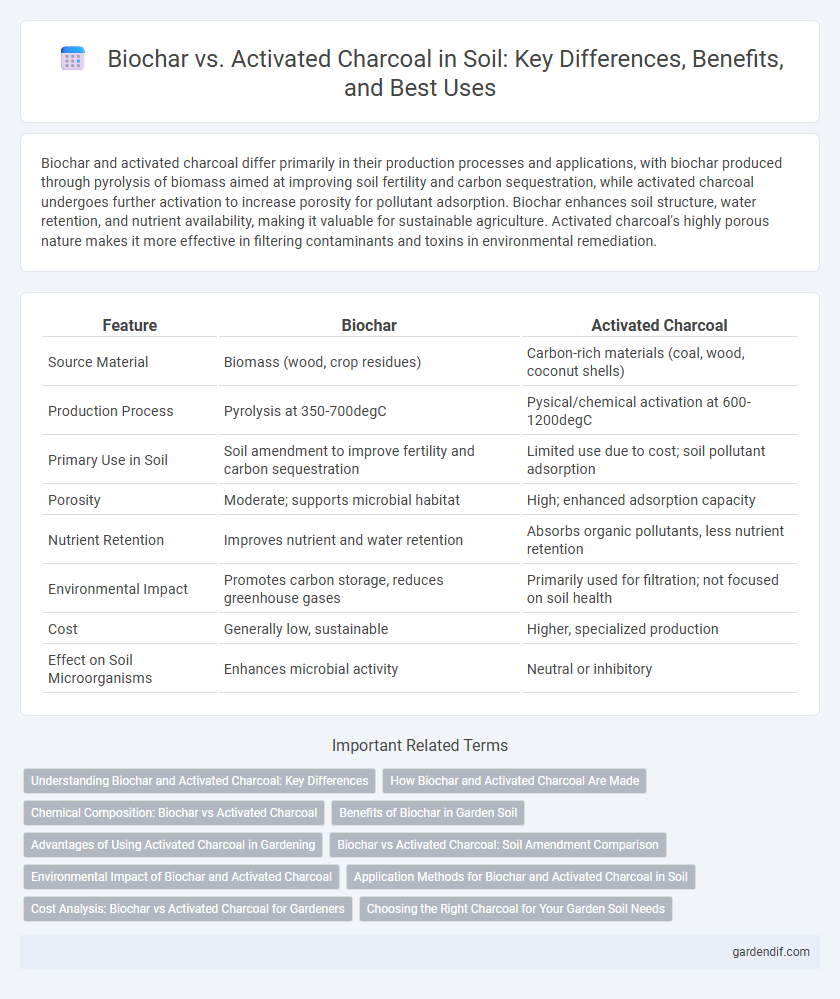
Biochar vs Activated charcoal Illustration
Biochar and activated charcoal differ primarily in their production processes and applications, with biochar produced through pyrolysis of biomass aimed at improving soil fertility and carbon sequestration, while activated charcoal undergoes further activation to increase porosity for pollutant adsorption. Biochar enhances soil structure, water retention, and nutrient availability, making it valuable for sustainable agriculture. Activated charcoal's highly porous nature makes it more effective in filtering contaminants and toxins in environmental remediation.
Table of Comparison
| Feature | Biochar | Activated Charcoal |
|---|---|---|
| Source Material | Biomass (wood, crop residues) | Carbon-rich materials (coal, wood, coconut shells) |
| Production Process | Pyrolysis at 350-700degC | Pysical/chemical activation at 600-1200degC |
| Primary Use in Soil | Soil amendment to improve fertility and carbon sequestration | Limited use due to cost; soil pollutant adsorption |
| Porosity | Moderate; supports microbial habitat | High; enhanced adsorption capacity |
| Nutrient Retention | Improves nutrient and water retention | Absorbs organic pollutants, less nutrient retention |
| Environmental Impact | Promotes carbon storage, reduces greenhouse gases | Primarily used for filtration; not focused on soil health |
| Cost | Generally low, sustainable | Higher, specialized production |
| Effect on Soil Microorganisms | Enhances microbial activity | Neutral or inhibitory |
Understanding Biochar and Activated Charcoal: Key Differences
Biochar and activated charcoal differ primarily in their production processes and soil applications; biochar is created through pyrolysis of organic matter at lower temperatures, enhancing soil fertility by improving nutrient retention and microbial activity. Activated charcoal undergoes higher-temperature activation, resulting in a highly porous structure used mainly for contaminant adsorption and toxin removal. In soil management, biochar supports long-term soil health, while activated charcoal is more suited for targeted pollutant remediation.
How Biochar and Activated Charcoal Are Made
Biochar is produced through pyrolysis, a process that involves heating organic biomass in a low-oxygen environment, resulting in a stable, carbon-rich material beneficial for soil enhancement. Activated charcoal undergoes a two-step process including carbonization of carbon-rich materials followed by activation, typically using steam or chemical agents, to increase its surface area and adsorption capacity. The differences in production methods affect their structure and functionality, making biochar more suitable for long-term soil amendment, while activated charcoal excels in filtration and adsorption applications.
Chemical Composition: Biochar vs Activated Charcoal
Biochar primarily consists of stable carbon compounds such as aromatic carbon rings, along with ash minerals like calcium, potassium, and magnesium, enhancing soil nutrient availability. Activated charcoal is rich in highly porous carbon with a large surface area and functional groups like hydroxyl and carboxyl, promoting adsorption of contaminants. The chemical composition difference influences biochar's long-term soil amendment properties versus activated charcoal's use in filtration and detoxification.
Benefits of Biochar in Garden Soil
Biochar enhances garden soil by improving nutrient retention, increasing water-holding capacity, and promoting beneficial microbial activity, leading to healthier plant growth. Its porous structure helps prevent nutrient leaching and supports soil aeration, which is vital for root development. Unlike activated charcoal, biochar is specifically designed for soil amendment, providing long-term benefits and carbon sequestration.
Advantages of Using Activated Charcoal in Gardening
Activated charcoal enhances soil aeration and improves water retention, promoting healthier root development and increased nutrient uptake in plants. It effectively adsorbs harmful toxins, pesticides, and heavy metals, reducing soil contamination and boosting microbial activity. Its porous structure supports a thriving soil microbiome, leading to improved plant growth and resilience against diseases.
Biochar vs Activated Charcoal: Soil Amendment Comparison
Biochar enhances soil fertility by improving nutrient retention, water holding capacity, and microbial activity due to its porous structure and stable carbon content. Activated charcoal, primarily used for filtration, has a more refined surface area but lacks the soil nutrient benefits offered by biochar. Biochar's long-term carbon sequestration and soil amendment capabilities make it superior for sustainable agriculture compared to activated charcoal.
Environmental Impact of Biochar and Activated Charcoal
Biochar enhances soil health by sequestering carbon and improving nutrient retention, thereby reducing greenhouse gas emissions and mitigating climate change. Activated charcoal, while effective in contaminant adsorption, often involves energy-intensive production processes that can result in higher carbon footprints. The environmental impact of biochar is generally considered more sustainable due to its role in long-term carbon storage and soil ecosystem benefits.
Application Methods for Biochar and Activated Charcoal in Soil
Biochar is commonly applied by incorporating it directly into the soil, often through tilling or mixing at rates between 5-20 tons per hectare to enhance soil fertility, water retention, and carbon sequestration. Activated charcoal is usually applied in smaller quantities as a soil amendment or mixed with compost to adsorb toxins and improve soil aeration without significantly altering soil structure. Both materials benefit from pre-charging with nutrients or microbes before application to maximize their positive effects on soil health and plant growth.
Cost Analysis: Biochar vs Activated Charcoal for Gardeners
Biochar typically costs less per ton than activated charcoal, making it a more affordable option for gardeners seeking soil amendments. While activated charcoal requires energy-intensive processes that drive up production costs, biochar is often produced from agricultural waste through low-cost pyrolysis. This price difference allows biochar to provide a cost-effective means of improving soil fertility and moisture retention for sustainable gardening.
Choosing the Right Charcoal for Your Garden Soil Needs
Biochar and activated charcoal serve distinct roles in garden soil management, with biochar enhancing soil fertility and water retention due to its porous structure and nutrient-holding capacity. Activated charcoal, primarily used for toxin absorption, is less effective in improving soil health but excels in removing contaminants from water or soil. Selecting the right charcoal depends on your garden's specific needs: biochar is ideal for enriching soil and increasing microbial activity, while activated charcoal targets purification and pollutant remediation.
Biochar vs Activated charcoal Infographic

 gardendif.com
gardendif.com